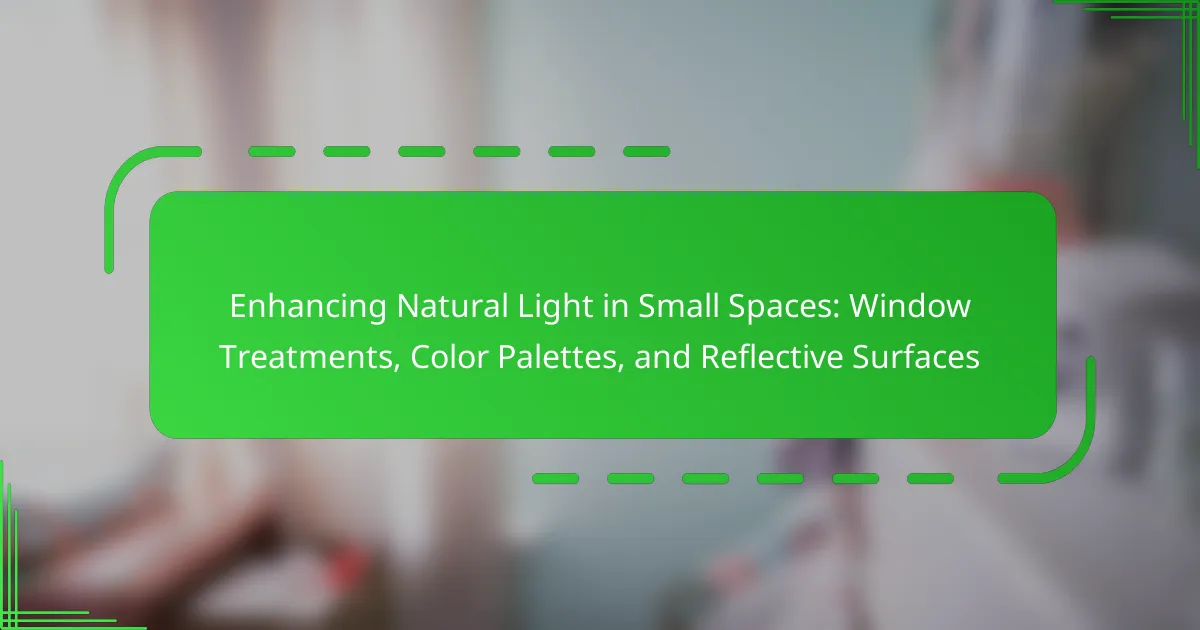Enhancing natural light in small spaces involves three key elements: window treatments, light color palettes, and reflective surfaces. Strategic window treatments, such as sheer curtains, maximize light entry while ensuring privacy. Utilizing light color palettes, particularly whites and pastels, contributes to a brighter and more open atmosphere. Additionally, incorporating reflective surfaces like mirrors and glossy finishes helps to distribute light throughout the room, creating an illusion of increased space and brightness. These techniques collectively improve the perception of light and spaciousness in compact areas.

What are the key elements of enhancing natural light in small spaces?
Key elements of enhancing natural light in small spaces include strategic window treatments, light color palettes, and reflective surfaces. Window treatments such as sheer curtains allow more light to enter while maintaining privacy. Light color palettes, including whites and pastels, help to reflect light and create an airy feel. Reflective surfaces, like mirrors and glossy finishes, bounce light around the room, making it appear larger and brighter. These strategies collectively increase the perception of space and brightness in small areas.
How do window treatments influence natural light in small spaces?
Window treatments significantly influence natural light in small spaces. They can either enhance or block light depending on their design and material. Sheer fabrics allow light to filter through while maintaining privacy. Conversely, heavier drapes can absorb light and make a space feel darker. The color of window treatments also plays a role; light colors reflect more light, while dark colors absorb it. Additionally, the positioning of treatments affects light entry; treatments mounted higher or wider can create the illusion of larger windows. According to a study by the American Society of Interior Designers, strategic use of window treatments can increase perceived space and brightness.
What types of window treatments maximize light exposure?
Sheer curtains maximize light exposure. They allow sunlight to filter through while providing some privacy. Roller shades in light colors also enhance light entry. These shades can be adjusted to control brightness. Blinds with wide slats permit more light when fully opened. Additionally, lightweight drapes can be tied back to open up the window space. Each of these treatments contributes to a brighter environment.
How can the placement of window treatments affect light entry?
The placement of window treatments significantly affects light entry. Treatments positioned closer to the window allow more light to enter. Conversely, those placed further away can obstruct light. The type of treatment also matters; sheer fabrics permit more light than heavy drapes. Additionally, mounting treatments above the window can create an illusion of height, maximizing light. Studies show that optimal placement can increase natural light by up to 30%. Properly arranged window treatments enhance both brightness and ambiance in small spaces.
What role do color palettes play in enhancing natural light?
Color palettes play a significant role in enhancing natural light. Light colors reflect more sunlight, creating a brighter atmosphere. Dark colors absorb light, which can make a space feel smaller and dimmer. For instance, white and pastel shades can maximize light reflection. According to studies, lighter hues can increase perceived space and brightness. In contrast, deep colors can limit the effectiveness of natural light. The strategic use of color can thus influence the overall ambiance of a room.
Which colors are best for reflecting light in small spaces?
The best colors for reflecting light in small spaces are light shades such as white, pale yellow, and soft pastels. These colors have high reflectivity, which helps to bounce light around the room. White reflects about 80-90% of light, making it the most effective choice. Light yellow can reflect around 70-80% of light, adding warmth while still enhancing brightness. Soft pastels, like light blue or mint green, also reflect light effectively, typically around 60-70%. Using these colors can create an illusion of a larger and brighter space.
How can color choices impact the perception of space and light?
Color choices significantly influence the perception of space and light. Light colors can make a room feel larger and more open. For instance, using white or light pastels reflects more natural light. This reflection creates an airy atmosphere, enhancing the feeling of space. Dark colors absorb light, making areas appear smaller and more confined. Research indicates that lighter shades can increase brightness by up to 20%. Additionally, color temperature affects mood and spatial perception. Warmer tones can create a cozy feel, while cooler tones can promote calmness. Thus, strategic color selection is essential in design for optimizing space and light perception.
What are the benefits of using reflective surfaces to enhance natural light?
Reflective surfaces enhance natural light by increasing brightness in a space. They do this by bouncing light around the room. This can make small spaces feel larger and more open. Reflective surfaces include mirrors, glossy paints, and metallic finishes. These materials can effectively multiply the amount of light available. Studies show that using reflective surfaces can reduce the need for artificial lighting. This leads to energy savings and lower electricity bills. Additionally, enhanced natural light can improve mood and productivity.
How do different reflective materials vary in effectiveness?
Different reflective materials vary in effectiveness based on their reflectivity and surface texture. Highly reflective materials, like polished aluminum, can reflect up to 90% of light. This makes them ideal for enhancing natural light in small spaces. In contrast, materials with a matte finish, such as painted drywall, reflect less light. They typically reflect around 30% to 50% of light, reducing overall brightness.
Glass surfaces can also vary; clear glass reflects about 8% of light, while frosted glass reflects more due to its texture. Furthermore, the color of reflective materials impacts their effectiveness. Lighter colors reflect more light than darker shades. For instance, white surfaces can reflect up to 80% of light, while dark colors may absorb more light.
The placement and angle of reflective materials also play a crucial role. Strategically positioning mirrors or reflective panels can maximize light distribution. Overall, the effectiveness of reflective materials depends on their type, finish, color, and placement.
What are practical applications of reflective surfaces in small spaces?
Reflective surfaces in small spaces can enhance light and create an illusion of space. Mirrors are commonly used on walls to reflect natural light, making rooms appear larger. Reflective furniture, such as glass or metallic finishes, can also amplify brightness. Using reflective tiles in bathrooms or kitchens can create a sense of depth. Additionally, light-colored reflective surfaces can help bounce sunlight around the room. Research indicates that these applications can improve mood and reduce the need for artificial lighting. Studies show that well-lit spaces contribute to increased productivity and well-being.
How can window treatments, color palettes, and reflective surfaces work together?
Window treatments, color palettes, and reflective surfaces can enhance natural light in small spaces by working in harmony. Window treatments, such as sheer curtains, allow light to filter through while providing privacy. Color palettes that include light and neutral tones can amplify the effect of natural light. Reflective surfaces, like mirrors and glossy finishes, bounce light around the room, creating a brighter environment. When combined, these elements create an illusion of spaciousness. For instance, placing mirrors opposite windows maximizes light reflection. Studies show that lighter colors can increase the perception of space by up to 15%. This synergy among window treatments, color palettes, and reflective surfaces is essential for optimizing natural light in confined areas.
What strategies can be employed for a cohesive design approach?
A cohesive design approach can be achieved through the use of consistent color palettes, unified materials, and harmonious textures. Consistent color palettes create visual unity and can enhance the perception of space. Unified materials, such as matching flooring and furniture finishes, contribute to a seamless look. Harmonious textures, like combining soft fabrics with sleek surfaces, add depth without overwhelming the space. Additionally, utilizing reflective surfaces can amplify natural light, making small areas feel larger and more inviting. Research shows that cohesive design improves user experience and satisfaction in interior spaces.
What are some practical tips for enhancing natural light in small spaces?
To enhance natural light in small spaces, use light-colored walls and ceilings. Light colors reflect more sunlight, making the area feel brighter. Incorporate mirrors to reflect light throughout the room. Position mirrors opposite windows for maximum effect. Use sheer window treatments to allow more light in while maintaining privacy. Avoid heavy drapes that block sunlight. Keep furniture and decor minimal to prevent clutter and obstruction of light. Use multi-functional furniture that allows for open space. Finally, consider adding skylights or light tubes for additional natural light sources. These strategies can significantly improve the brightness in small areas.
How can homeowners implement these strategies effectively?
Homeowners can effectively implement strategies to enhance natural light by selecting appropriate window treatments. Choosing sheer curtains allows sunlight to filter in while maintaining privacy. Using light-colored paint on walls and ceilings reflects more light, making spaces feel larger. Mirrors can be strategically placed to bounce light around the room. Opting for glossy finishes on furniture and surfaces can also amplify brightness. Additionally, homeowners should consider the layout of their space to maximize light exposure. Keeping windows unobstructed by furniture ensures an uninterrupted flow of natural light. These methods are supported by design principles that emphasize light reflection and openness in small areas.
What common mistakes should be avoided when enhancing natural light?
Common mistakes to avoid when enhancing natural light include using heavy window treatments. Heavy drapes block sunlight and create darkness in a room. Another mistake is painting walls in dark colors. Dark colors absorb light and make spaces feel smaller. Neglecting mirrors is also a common error. Mirrors can reflect light and create an illusion of more space. Additionally, placing furniture in front of windows obstructs light. This limits the amount of natural light entering the room. Lastly, failing to consider the orientation of windows is crucial. South-facing windows receive more sunlight, while north-facing ones receive less. Understanding these factors can significantly improve natural light in small spaces.
Enhancing natural light in small spaces focuses on three key elements: window treatments, color palettes, and reflective surfaces. Strategic window treatments, such as sheer curtains, optimize light entry while maintaining privacy. Light color palettes, including whites and pastels, reflect sunlight, creating a brighter atmosphere. Reflective surfaces, like mirrors and glossy finishes, further amplify brightness and the perception of space. This article outlines effective strategies and practical tips for maximizing natural light, improving ambiance, and enhancing overall design in confined areas.
